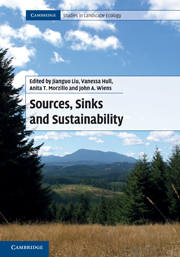Book contents
- Frontmatter
- Contents
- Contributors
- Preface
- Acknowledgments
- Part I Introduction
- Part II Advances in source–sink theory
- 2 Evolution in source–sink environments: implications for niche conservatism
- 3 Source–sink dynamics emerging from unstable ideal free habitat selection
- 4 Sources and sinks in the evolution and persistence of mutualisms
- 5 Effects of climate change on dynamics and stability of multiregional populations
- 6 Habitat quality, niche breadth, temporal stochasticity, and the persistence of populations in heterogeneous landscapes
- 7 When sinks rescue sources in dynamic environments
- 8 Sinks, sustainability, and conservation incentives
- Part III Progress in source–sink methodology
- Part IV Improvement of source–sink management
- Part V Synthesis
- Index
- References
5 - Effects of climate change on dynamics and stability of multiregional populations
Published online by Cambridge University Press: 05 July 2011
- Frontmatter
- Contents
- Contributors
- Preface
- Acknowledgments
- Part I Introduction
- Part II Advances in source–sink theory
- 2 Evolution in source–sink environments: implications for niche conservatism
- 3 Source–sink dynamics emerging from unstable ideal free habitat selection
- 4 Sources and sinks in the evolution and persistence of mutualisms
- 5 Effects of climate change on dynamics and stability of multiregional populations
- 6 Habitat quality, niche breadth, temporal stochasticity, and the persistence of populations in heterogeneous landscapes
- 7 When sinks rescue sources in dynamic environments
- 8 Sinks, sustainability, and conservation incentives
- Part III Progress in source–sink methodology
- Part IV Improvement of source–sink management
- Part V Synthesis
- Index
- References
Summary
Climate change is one of the greatest long-term potential threats to the functional integrity of the biosphere. Although the likely effects of climate change on ecosystem function and the geographic distributions of organisms have been extensively studied, their demographic effects are less well understood. In order to examine the effects of climate change on populations in their landscape context, I integrate results from two different modeling approaches to examine the effects of climate change on the demography and dispersal of organisms. I use simple two-patch metapopulation models and more complex stochastic stage-structured multiregional models of stream fish populations. Plausible effects of climate change on dispersal rates, and on spatial population structure, may destabilize metapopulations and make them susceptible to further anthropogenic or natural perturbations. The findings suggest several hypotheses to be tested empirically, and imply that future biodiversity conservation strategies will need to account for the landscape-level effects of climate change and attendant changes in land use.
- Type
- Chapter
- Information
- Sources, Sinks and Sustainability , pp. 99 - 114Publisher: Cambridge University PressPrint publication year: 2011

